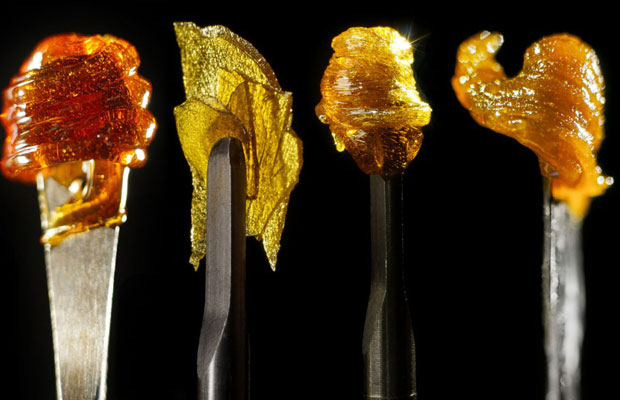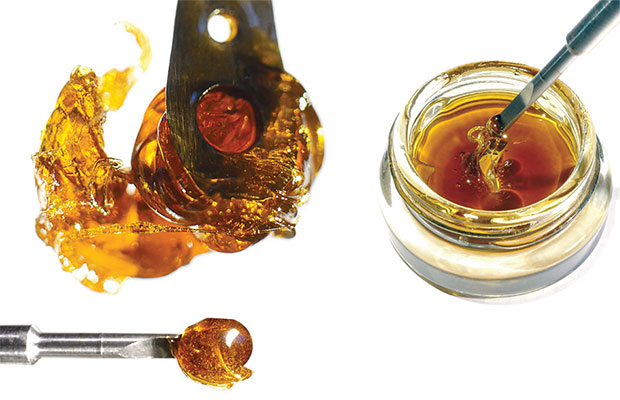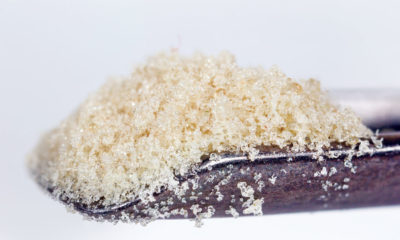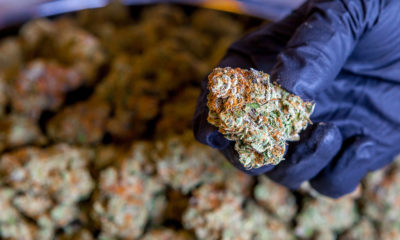
Concentrates
Dab Drought: Oregon’s Legalization is Killing Concentrates
Oregon’s medical cannabis patients — especially those with serious illnesses — have come to rely on high-potency cannabis extracts for relief of their conditions. But regulatory obstacles are making it next to impossible for some to find medicine.
After months of drought, hashes, edibles, tinctures and topicals are slowly making their way back onto dispensary shelves in Oregon. In the area around Portland, the state’s biggest city, there are over 200 legal storefronts serving both medical and recreational purchasers, and almost every single one of them has been dry for months — and the new legalization regulations are to blame.
Bringing Oregon’s societally-ingrained marijuana community and industry into a legal framework has proven to be a logistical boondoggle that, while adding many consumer protections, has also shuttered access to much of the state’s patient population and constructed significant barriers for small, heritage growers trying to enter the legal market.
At the heart of the issue are the new classifications themselves: is medical marijuana actually different than recreational? Should it be produced and controlled separately from adult use? And are current legalization schemes being sold on the promise of economic opportunity and safety, but instead delivering regulations set up to favor cannabis conglomeration?
Where did all the hash go?
“The [hash] drought was caused by a bottleneck created around the new testing guidelines for pesticides,” said Anthony Johnson, chief petitioner of Measure 91, the voter initiative that legalized marijuana in November 2014.
Johnson also sat on the compliance and enforcement subcommittee of the Oregon Liquor Control Commission (OLCC) rule advisory committee, which was created to implement the law. He said the bottleneck began last Fall.
“As of October 1, [2016], new testing regulations and criteria took effect,” Johnson said. “The pesticide rules and criteria were so stringent most people who submitted extracted products were failing the pesticide tests and having to destroy them. The ones that did make it to market were being bought up so fast it was like it was never there.”
The Measure 91 campaign was clear that the initiative would not interfere with the current medical law, but Johnson said the legislature was already looking to reform the medical system before it passed. He acknowledged that the new regulations removed the incentive from the state caregiver programs — the backbone of the state’s medical laws and the mechanism that allows extremely ill people to be provided their medicine free of cost.
“[Oregon businesses] need to oppose efforts that disregard the existing infrastructure within the states that have legalized marijuana for everybody to use, because that is one of the things that has dramatically impacted Oregon’s program,” Johnson said. “They [the OLCC] refuse to allow the existing infrastructure to become the model for the legal program and it left all these small businesses by the wayside, and there isn’t much of a chance of getting that back.”
The concerns over concentrate safety are not baseless. In 2015, an investigation by The Oregonian found alarming levels of residual pesticides in products bought at licensed dispensaries. This along with reports of “card stacking” — the practice of over-recruiting patients to boost profit margins — led to a push for reform of the medical cannabis system.
Stacking the deck for cash
Under the old system, growers were permitted to grow six plants per patient and sell any excess product to medical dispensaries at a profit. With an abundance of rural farmland in the state, many growers responded by gathering as many recommendations as possible, growing each permitted plant as large as possible and banking on the surplus. This flooded the market with product, lowered prices and alarmed Oregon officials.
Under the new scheme, all recreational marijuana is regulated by the OLCC, while the medical cannabis system continues to be regulated by the Oregon Health Authority (OHA). Only licensed medical growers can grow for the medical market, and with the majority of that market re-routed to the higher-priced and high-taxed recreational side (medical remains tax-free), the incentive to grow directly for patients is gone.
With the separation of the cannabis market into the categories of “medical” and “recreational,” there are very few medical farmers and dispensaries left; the patient population has dwindled to just the seriously and chronically ill — those most in need of reliable access to medicine.
These patients can still buy products in recreational stores tax-free, but they will not have access to higher potencies required for treating their illnesses and must first be able to afford the $100 to $600 in licensing fees.
And while recreational cannabis sales are thriving — at least the raw flower — medical patients are finding it harder to find growers and products that fit their needs.
Recreational customers cannot enter medical-only shops, so fewer shops have decided to continue serving the medical market: in the tri-county Portland region, about 60 medical only shops remain of the over 250 licensed stores (and counting), many are in the process of obtaining recreational licenses.
“Business is at a standstill, I am not even generating enough revenues to pay the skeleton crew I have working there,” Frank Wallace, owner of Sirius Extracts and a dispensary in northeast Portland said. “Medical stores, in my opinion, unless they are in a place that don’t allow recreational at all, [some counties voted to ban], are not going to be able to make it.”
Wallace says they are currently awaiting OLCC licensing to sell to the recreational market. The hold up isn’t the OLCC, but the City of Portland, which has its own regulations in addition to the county and state for business operators to deal with.
Wallace’s other business, Sirius Extracts, has had a rocky year. Their business model was based on the abundance of small farmers who wanted to extract their products, but didn’t operate large enough operations to afford their own machinery for butane or CO2 extraction. After harvest, growers would bring the leaves trimmed away from the buds to an extractor like Sirius, who would either distribute it under their label with the farm’s name and split the profits, or sell it back to the grower so they could distribute it themselves: Wallace said the majority of his growers opted to distribute under the Sirius label.
The glut of growers and availability of extractor services flooded the cannabis market with popular concentrates, in turn lowering the price to consumers. Patients, in particular, came to rely on affordable hashes and concentrates for treatment.
But Wallace said that many of the growers he worked with are unable to join the legal recreational market.
“They can’t make it to be recreational producers either because of a lack of money, lack of water rights, proper zoning or any of those kinds of things,” he said. “A lot of really good medical growers are just going to have to close down or they can continue to grow for the medical market, but the medical market, as far as purchases go, is almost dead.”
And although extracted products are produced in a variety of ways — many of which are safely done with water or by sifting — the state is regulating all of these products the same way, including full extract cannabis oil (FECO), a product patients have come to rely on.

The Unintended Consequences of Legalization
Ilo Ferrogiaro has been growing cannabis in the region for over 30 years.
“I think [legalization] is a great thing, obviously, but they [the state] did it at the expense of the medical growers, the activists and the farmers that built this whole industry,” he said. “They shut us all out and opened up the door to out-of-state money. They made the licensing so expensive that pretty much anyone in it to help patients didn’t have the resources or funds to actually start a legal cannabis business.”
Ferrogiaro started growing in Northern California in the mid-1980s after watching close friends suffer and die from AIDS and cancer. He was arrested for cultivation in 1989 and stopped growing during the time he was on probation and parole, until the mid-1990s. After marrying his wife, they moved to Southern Oregon and started a state-legal medical farm to take care of patients.
“Being a grower, I did what I could,” he said. “But you can’t help everybody, and that is probably the hardest part of being a medical grower.”
Together, he and his wife expanded the farm’s offerings to include topicals, extracts and edibles that became popular with patients in their area. Before legalization, under state law the Ferrogiaros were able to provide free medicine to sick people and sell their excess to dispensaries at a profit.
More importantly, they were able to provide their patients with FECO (aka Rick Simpson Oil, RSO) — the highly potent condensed tar-like extraction of marijuana sought by cancer patients and others with serious and chronic illnesses.
Ferroggiaro says he used to extract using the trim from his harvests and sell it to a licensed store. But today, because the medical and recreational programs are managed separately, if the cannabis was grown for the medical side the extracts can also only be sold on that side and vice versa.
And while a recreational shop can sell products to medical patients, a medical shop cannot sell to recreational consumers. So with the majority of the market now identifying as “recreational,” the supply side of the medical cannabis program has been disincentivized.
“What that really means for us is that the state of Oregon said to the black market ‘go right ahead,’” Ferrogiaro said.
The Ferrogiaros have stopped producing FECO, topicals and other extracted products for their patients because they say the licensing is not affordable.
Ferrogiaro now only produces cannabis for the recreational market, but says he thinks there should be one simple license for all growers, regardless of which market they are serving.
“All of my friends that did not go legal are doing just fine. All the farms I know that went legal are scrambling to survive right now,” he said. “The state has to reinstate the medical program. You have thousands and thousands of growers who have been producing cannabis or cannabis products who used to legally bring product to market and cannot do that anymore.”
Phil Werner, another medical grower, is particularly concerned about the ability to provide medical patients with full extract oil. Werner said he got into medical cannabis cultivation because his wife has serious illnesses. He said she currently takes the oil and has a much better quality of life because of it.
At first, he grew only for her, but as he met more seriously ill people, he chose to grow for them too, which was legal under state law.
“The people who are truly in need can’t afford to go to a dispensary, they want $40/gram for [FECO]. That makes us no better than big pharma,” he said. “It is a squeeze play. They just don’t get the money they want out of medical marijuana. It is more profitable to do commercial or recreational. There is no other reason for it.”
Werner also echoed Ferrogiaro’s concerns about the illicit market filling the vacuum.
“There will always be shady characters, but for the most part, people were getting taken care of and it wasn’t costing them an arm and a leg to do so,” he said. “As the costs keep going up, smaller growers are just dropping off and either growing their own four plants or going rogue. They are setting up people like me to be outlaws… It has gotten to the point where capitalism is first and conscious is second. A lot of people who make full extract oil are looking at it as big money.”.
Since 1998, implementation of Oregon’s medical marijuana law has been tasked to the Oregon Health Authority (OHA). The OHA, however, has also been tasked with managing the state’s Affordable Care Act exchange and the Oregon Health Plan (OHP): the agency has made it clear they do not want to be responsible for also managing the Oregon Medical Marijuana Program (OMMP).
OHA’s former administrator, Tom Burns, confirmed this.
“The medical suppliers, growers and patients says ‘let us get it out of OHA to somebody who does want it and will work with us to make the program that works for us,’” Burns told the Blue Mountain Eagle.
In late February, representatives from the industry, patient advocate groups and legislators agreed on a plan to consolidate the medical and recreational programs under the OLCC and allow medical growers to receive a $200 license by providing 75 percent of their harvest to patients for free.
The plan must be approved by the full legislature to become law. With only 25 percent of product making it to stores, this scheme also disincentives medical storefronts, furthering the need for one-store-fits-all-uses licensing. Last week, the state floated the idea of easing regulations on pesticide testing to free up the over-burdened market.
What is clear is that the state still isn’t done shaping its marijuana policies, so everything could change again at the swivel of the governor’s pen. Meanwhile, Oregon’s patients, farmers and small businesses are at stake.
The Great Divide
If the regulatory cost of supplying the market with a high-demand agricultural product is too high, the illicit market will continue to thrive. And while regulation seemingly makes the market more “fair” by pushing users the government defines as “recreational” and “medical” into separate boxes, the reality remains that both markets have demands for the same or similar products and they are produced in the exact same ways.
“I think it is important to understand the correlation between cannabis regulation as a whole product, not just broken out into hemp, medical and recreational,” Wallace said. “It is a whole plant that is the same and used in the same ways by all demographics. We need to be careful those people who benefit most from the medical benefits of cannabis are not left by the wayside.”
And despite the varied reasons for cannabis use, the fact remains that the plant is safe for all consumers who have been properly educated on its effects.
Legalization campaigns extol the safety of the plant while regulations tend to err towards the hysterics that brought about prohibition in the first place, at the expense of the already-most vulnerable population in society — the sick.
TELL US, are you in Oregon? Have you experienced the dab drought?




















